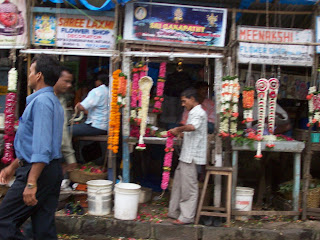
Goa, the smallest state in India, was conquered by Vasco de Gama and is heavily Catholic today, but is mostly known as a beach resort for Bangaloreans, Mumbaikars, and British vacationers ranging in color from ivory to brick, depending on minutes in the sun. The pristine beaches lie to the south, where we (13 classmates, me and 3 Danish joiners) didn't get to really explore. We were in the tourist district, albeit during the off-season. The beach pictured, Baga beach, features shack restaurants made of palm fronds and tarp, serving up sandwiches with "lattis" and employees on the beach front enticing you with offers of "lounge chair," Kingfisher (the ubiquitous Indian beer), and, in one special establishment, "English toilet." We didn't go in the water because riptides are prevalent at the end of monsoon season, and because we walked by the sewage pipe on the way to eat.
We spent several hours over a few days exploring Panaji or Panjim, depending on whether you favor the Hindi or Portuguese rendition of the Goan capital. Since India has so many languages in the mix, there are often more than one way to spell and pronounce place names--for example, you can pronounce the Maharashtran city, Pune, either "POO-nay" or "POO-nuh" and I've caught people doing both in the same sentence. It makes things a little easier for those of us who don't instinctively know.
Panaji is a port city with a beautiful market and great places to eat. Goan cuisine is heavy on seafood, marrying Portuguese and Indian spices. We found a fantastic fish curry at a restaurant in town, a thinner thai red curry marinating a small pomfret with sides of okra and rice, which came to about 85 cents. I couldn't take a picture because I was basically distinguishing my classmates across the table by sound, unfortunately. As advertised, the place was partially air-conditioned (not our part) and they also saved some rupees on lighting fixtures by abstaining from buying them. Below are Colin, Ben and Rachel, and Forest who may be blind now from emerging without sunglasses.

Goan drinks are not as user-friendly as the food. We were told that notches on coconut palms are footholds for toddy-tappers climbing up to extract coconut sap which is turned into one of two varieties of feni, the other being cashew feni. When Rachel tried to order it, the waiter explained that it is ok if you mix it with "enough of anything," but only "if you don't mind the stink." After several reassurances that she would like to try it, followed by several gentle reminders about the smell, Rachel discovered why Goa exports salt to Dubai and cashews to the rest of India, but not a ton of feni.

We hit the market several days later, on the hunt for tacky shell sculptures, nonsensical English t-shirts, and shoes that would fit only our hands. We were in luck. Although I didn't buy the "Tennis Party Girl" shirt, Rachel found a Ganesh icon made entirely out of shells and visible glue and Colin located a belt that said "The Tiger Club" and then listed Rolling Stones songs.
Indian markets are filled with people stringing marigolds and roses, which are bought to hang in temples and on altars in homes.

Many of the stalls were closing up and I'd seen a guy grabbing armloads of marigolds and dropping them into a bag to keep for the night. I asked him to repeat the action for a picture, but he misinterpreted what I'd wanted to see. . .
 It seems like a comparatively cushy job in Goa, since in Mumbai, the flower market in my neighborhood features four workers per double-decker 7-foot hut, where flower stringers work and sleep (check under the tables).
It seems like a comparatively cushy job in Goa, since in Mumbai, the flower market in my neighborhood features four workers per double-decker 7-foot hut, where flower stringers work and sleep (check under the tables). Back in Panaji, the fish market was by far the most exciting, mostly because I haven't been down to the one in Mumbai yet. I'm not sure who fishes in Goa, but the selling seems to be in the hands of the women.
Back in Panaji, the fish market was by far the most exciting, mostly because I haven't been down to the one in Mumbai yet. I'm not sure who fishes in Goa, but the selling seems to be in the hands of the women.



No comments:
Post a Comment